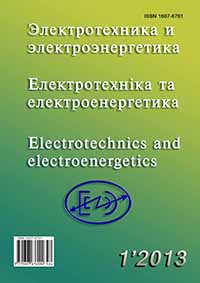THE NUMERICAL FIELD ANALYSIS OF EXCITATION MODES AND OF THE DIFFERENT TYPES OF THE ARMATURE REACTION IN A POWERFUL TURBOGENERATOR
DOI:
https://doi.org/10.15588/1607-6761-2013-1-11Keywords:
turbogenerator, numerical-field analysis, magnetic fields, modes of excitation, types of the armature reaction, vector diagramsAbstract
Principle and the numerical field analysis results of the different excitation modes and of the different types of the armature reaction of powerful turbogenerator are presented. A selection of the the magnetic field excitation factors in the idle mode, the rated load and short-circuit, as well as those specific modes that are characterized by longitudinal demagnetizing and magnetizing and more cross-reaction of the armature excitation of the magnetic field only the stator winding along the longitudinal and transverse axes of the rotor is shown. The principle, which allows by the results of the magnetic field calculation in each mode to determine the key electromagnetic values (magnetic flux and EMF) and the phase relationship between them and the currents is considered. The pictures of the magnetic fields are graphically presented in all modes, and the principle of the corresponding vector diagrams construction is also presented on the basis of calculation of these fields. In the original received vector diagrams it is possible to identify qualitatively and quantitatively the share and role of the magnetic field of the rotor and the stator magnetic field. The conducted research can be the basis for improving the system of study, analysis and design of turbogenerators and other electric machines because the considered method of analysis of magnetic fields is quite universalReferences
Вольдек А.И. Электрические машины / А. И. Вольдек. – Л. : Энергия, 1978. – 832 с.
Титов В.В. Турбогенераторы / В. В. Титов, Г. М. Хуторецкий, Г. А. Загородная и др. – Л. : Энергия, 1967. – 895 с.
Meeker D. Finite Element Method Magnetics. Version 4.2. User’s Manual, September 26, 2006 // http://femm.berlios.de.
Милых В.И. Определение электромагнитных параметров электрических машин на основе численных расчетов магнитных полей / В. И. Милых, Н. В. Полякова // Електротехніка і електромеханіка. – 2006. –№ 2. – С. 40–46.
Милых В.И. Система направлений и фазовых соотношений электромагнитных величин при численных расчетах магнитных полей в турбогенераторе /В. И. Милых, Н. В. Полякова // Електротехніка і електромеханіка. – 2011. – № 5. – С. 33–38.
МилыхВ.И. Гармонический анализ электромагнитных величин трехфазной обмотки статора турбогенератора на основе классических и численно-полевых методов / В.И. Милых, Н.В. Полякова // Технічна електродинаміка. – 2013. – № 3. – С. 40–49.
Милых В.И. Организация численного расчета магнитного поля турбогенератора в режиме нагрузки с обеспечением заданных его выходных параметров /В. И. Милых, Н. В. Полякова // Електротехніка і електромеханіка. – 2012. – № 1. – С. 36–41.
Корн Г. Справочник по математике для научных работников и инженеров / Г. Корн, Т. Корн. – М. : Наука, 1973. – 832 с.
Downloads
How to Cite
Issue
Section
License
Copyright (c) 2017 V. I. Milykh, N. V. Polyakova

This work is licensed under a Creative Commons Attribution 4.0 International License.
Creative Commons Licensing Notifications in the Copyright Notices
Authors who publish with this journal agree to the following terms:
Authors retain copyright and grant the journal right of first publication with the work simultaneously licensed under aCreative Commons Attribution License that allows others to share the work with an acknowledgement of the work's authorship and initial publication in this journal.
Authors are able to enter into separate, additional contractual arrangements for the non-exclusive distribution of the journal's published version of the work (e.g., post it to an institutional repository or publish it in a book), with an acknowledgement of its initial publication in this journal.
Authors are permitted and encouraged to post their work online (e.g., in institutional repositories or on their website) prior to and during the submission process, as it can lead to productive exchanges, as well as earlier and greater citation of published work.

